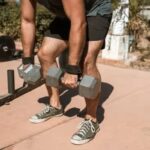What are the misconceptions about fitness and exercise? Many people hold misunderstandings about what it takes to get fit and stay in shape. In this article, we will explore some of the most common myths surrounding fitness and exercise and uncover the truth behind these misconceptions. By debunking these myths, we hope to promote a more informed approach to achieving overall health and wellness.
One of the most prevalent misconceptions is that cardio is the only way to lose weight and get in shape. Additionally, there is a belief that lifting weights will make women bulky. Many individuals also think that spending hours in the gym is necessary to see results. These are just a few examples of the myths we will address in this article as we seek to provide clarity on what it truly takes to achieve fitness goals.
As we delve into each misconception, it’s important to recognize that an informed understanding of fitness and exercise can lead to more effective strategies for reaching personal health goals. By challenging these myths, individuals can develop a more well-rounded approach that encompasses various aspects of physical activity, nutrition, and overall well-being. Let’s dive into the common misconceptions about fitness and exercise and find out the real facts behind them.
Myth #1
Cardiovascular exercise, such as running, biking, or swimming, is often seen as the Holy Grail of weight loss and fitness. While it is true that cardio can help you burn calories and improve your endurance, it is not the only way to achieve these goals. In fact, solely focusing on cardio may neglect other important aspects of overall fitness.
One common misconception about fitness and exercise is that strength training plays a secondary role to cardio in achieving weight loss and getting in shape. However, incorporating a balanced workout routine that includes strength training is essential for building muscle, improving bone density, and boosting metabolism. Additionally, having more lean muscle mass can contribute to burning more calories at rest.
It is important to remember that achieving overall health and fitness requires a well-rounded approach that includes a combination of cardiovascular exercise, strength training, flexibility work, and proper nutrition. Understanding the importance of incorporating different types of exercises into your routine can help you dispel the myth that cardio is the only way to lose weight and get in shape.
By embracing a diverse range of physical activities, individuals can tailor their workouts to their specific needs and goals while reaping the many benefits of a comprehensive fitness regimen.
Myth #2
When it comes to fitness and exercise, one of the most common misconceptions is that lifting weights will make women bulky. This myth has prevented many women from incorporating strength training into their workout routine out of fear of developing a masculine physique.
However, the truth is that unless women are specifically training for bodybuilding and consuming a high-calorie diet, it is physiologically impossible for them to become bulky from lifting weights. In fact, strength training offers numerous benefits for women, including increased muscle tone, improved metabolism, and enhanced bone density.
Research has shown that adding resistance training to one’s exercise regimen can help women achieve a lean and toned appearance without bulk. Additionally, strength training can aid in fat loss and improve overall body composition. It is important for women to understand that lifting weights will not automatically result in a bulky physique but rather contribute to a strong and healthy body.
According to the American College of Sports Medicine (ACSM), a well-rounded exercise program for women should include both cardiovascular activities and strength training. By dispelling the misconception that lifting weights will make women bulky, more individuals may feel empowered to engage in diverse forms of exercise and reap the full benefits of a comprehensive fitness routine.
| Benefit | Effect |
|---|---|
| Increased muscle tone | Improved overall body composition |
| Enhanced metabolism | Increased bone density |
Myth #3
It is a common misconception that spending hours in the gym is the only way to see results from exercise. Many people believe that if they can’t dedicate large amounts of time to working out, then there’s no point in even trying. This couldn’t be further from the truth.
In reality, the quality of your workout is much more important than the quantity of time spent in the gym. High-intensity interval training (HIIT) has been proven to be an effective way to burn fat and improve cardiovascular health in a short amount of time. Shorter, more intense workouts can be just as beneficial as longer ones, making it possible to fit exercise into even the busiest schedules.
Additionally, incorporating resistance training into your workout routine can lead to significant improvements in muscle strength and endurance, even with shorter workouts. By focusing on compound movements that work multiple muscle groups at once, such as squats, deadlifts, and push-ups, you can maximize your time in the gym and see results without having to spend hours working out.
Ultimately, it’s important for individuals to understand that consistency and intensity are key factors in seeing results from exercise, not just the amount of time spent working out. By debunking the myth that hours need to be dedicated to fitness in order to see progress, individuals can feel empowered to prioritize physical activity in their daily lives regardless of their busy schedules.
Myth #4
Sweating and Fat Loss
Many people believe that the more they sweat during a workout, the more fat they are burning. However, sweating is simply the body’s way of cooling down and regulating temperature.
While it’s true that you may lose some water weight through sweating, it does not necessarily equate to fat loss. In fact, some people may sweat more than others due to genetics or their body’s natural cooling system, but this does not indicate how effective their workout is for fat burning.
Measuring Fat Loss
To accurately measure fat loss, it’s important to focus on other indicators such as changes in body composition, like increased muscle mass and decreased body fat percentage. Monitoring progress through measurements, photos, or how clothes fit can also be more accurate measures of fat loss rather than simply relying on sweat as an indicator.
Educating About Exercise Intensity
It’s crucial to educate individuals about exercise intensity and its role in fat burning. High-intensity workouts can be effective for burning calories and increasing metabolism even if one doesn’t sweat profusely.
Encouraging a balanced approach to exercise that includes strength training, cardiovascular workouts, and proper nutrition can help individuals achieve their fitness goals without focusing solely on sweat as an indicator of success. By debunking this misconception about sweating and fat loss, people can develop a more informed approach to fitness and exercise.
Myth #5
Many people believe that as long as they exercise regularly, they can eat whatever they want without any consequences. This is a common misconception about fitness and exercise that can lead to an unhealthy lifestyle. While exercise is important for overall health and wellness, it cannot undo the negative effects of a poor diet.
It’s important to understand that the food you consume plays a significant role in your overall health and fitness goals. A balanced diet that includes a variety of nutritious foods is essential for fueling your workouts and supporting your body’s recovery. Eating a diet high in processed foods, sugar, and unhealthy fats can hinder your progress, no matter how much you exercise.
To debunk this myth, it’s important to emphasize the importance of balance when it comes to nutrition and exercise. Educating individuals on the significance of making healthy food choices alongside their workout routine is crucial for achieving optimal results. Here are some key points to consider:
- Focus on consuming whole foods such as fruits, vegetables, lean proteins, and whole grains
- Limit your intake of processed foods, sugary drinks, and excessive amounts of unhealthy fats
- Pay attention to portion sizes and practice mindful eating
By debunking the myth that you can eat whatever you want as long as you exercise, individuals can adopt a more holistic approach to their health and well-being.
Myth #6
Many people believe that age is a determining factor when it comes to starting an exercise routine and seeing results. However, this is a common misconception about fitness and exercise. The truth is that it’s never too late to start exercising, and people of all ages can experience the benefits of physical activity.
Here Are Some Important Points to Consider
– Exercise is beneficial for older adults: Contrary to popular belief, seniors can still improve their strength, balance, flexibility, and cardiovascular health through regular exercise. In fact, physical activity can help older adults maintain their independence and reduce their risk of chronic conditions such as heart disease, diabetes, and arthritis.
– It’s never too late to see improvements: While younger individuals may experience quicker results due to their higher metabolism and muscle mass, older adults can still make significant progress with consistency and dedication. It’s important to set realistic goals and understand that progress may take longer, but it is definitely achievable.
– Different types of exercise are suitable for different ages: As people age, their abilities and needs change. Low-impact activities such as walking, swimming, yoga, or tai chi are excellent options for older adults looking to stay active. These exercises can be adapted to accommodate different fitness levels while minimizing the risk of injury.
Myth #7
Many people believe that they can target specific areas of their body for fat reduction through exercise, but this is a common misconception about fitness and exercise. The idea of spot reduction suggests that by focusing on a certain area of the body with exercise, such as doing crunches to reduce belly fat, you can effectively eliminate fat from that specific area. However, it’s important to understand that spot reduction is a myth.
When you engage in physical activity, your body burns calories from all over, not just from the specific area you’re targeting. While certain exercises may help tone and strengthen specific muscles in a particular area, they do not directly burn the fat in that region. Fat loss occurs throughout the entire body as you create a calorie deficit through overall exercise and healthy eating habits.
For those looking to reduce fat in specific trouble areas, it’s essential to focus on achieving an overall healthy weight and body composition through a combination of cardiovascular exercise, strength training, and a balanced diet. By understanding the truth about spot reduction and adopting a comprehensive approach to fitness and exercise, individuals can work towards their goals in a more effective way.
Myth #8
There is a common misconception that fitness and exercise are only for individuals who want to lose weight. This belief can lead to the exclusion of many other valuable benefits that come from being physically active.
In reality, exercise is crucial for overall health and well-being, regardless of your weight or body composition. Engaging in regular physical activity has been linked to a range of positive outcomes, including improved mood, reduced stress levels, better sleep quality, and increased energy levels.
Physical activity also plays a vital role in reducing the risk of chronic diseases such as heart disease, diabetes, and certain types of cancer. It can help to strengthen bones and muscles, improve cardiovascular health, and enhance flexibility and balance. Exercise is not solely about changing one’s appearance; it is about preserving and enhancing one’s quality of life. Therefore, it is important to reframe the narrative around fitness and emphasize its holistic benefits beyond weight loss.
By perpetuating the idea that fitness is only for those aiming to shed pounds, we are excluding numerous individuals who could benefit from regular physical activity. It is essential to recognize that everyone can derive value from engaging in exercise, irrespective of their body size or weight goals. By debunking this myth, we can encourage a more inclusive approach to fitness that highlights its diverse array of advantages for people of all shapes and sizes.
Conclusion
In conclusion, it is important to debunk these common myths about fitness and exercise in order to promote a more informed approach to health and wellness. The misconceptions highlighted in this article are prevalent in society, leading many individuals to have misguided beliefs about what it takes to achieve their fitness goals. By addressing these myths, we can empower people to make better choices and see better results in their fitness journey.
By understanding that cardio is not the only way to lose weight, that weight lifting will not necessarily make women bulky, and that spending hours at the gym is not a requirement for seeing results, individuals can adopt a more balanced and effective approach to exercise.
Additionally, dispelling the myth that one can eat whatever they want as long as they exercise and that fitness is only for those looking to lose weight can lead to healthier habits and a more holistic view of physical activity.
Ultimately, it is crucial for individuals of all ages to understand the misconceptions surrounding fitness and exercise so they can make informed decisions about their health. By doing so, people can better prioritize their overall well-being and work towards achieving their fitness goals in a more sustainable manner. It’s time to move away from these misconceptions and embrace a well-rounded approach to health and fitness.
Frequently Asked Questions
What Are the Common Mistakes Observed With Exercise?
Common mistakes observed with exercise often include improper form or technique, pushing too hard too quickly, lack of proper warm-up and cool-down, and not listening to your body’s signals.
Which of the Following Is a Common Mistake Observed With Exercise?
A common mistake observed with exercise is pushing too hard too quickly. This can lead to injuries and burnout, as the body needs time to adapt and progress gradually in its workout routine.
Why Do Some People Like Exercise and Others Don’t?
Some people like exercise because it makes them feel good both mentally and physically. Endorphins released during physical activity can elevate mood and reduce stress. On the other hand, some people may not enjoy exercise due to previous negative experiences, lack of motivation, or simply not finding a form of exercise they enjoy.

Passionate about providing useful information to anyone with an interest in the field of Personal Training, I strive to pass on to our readers quality information and to answer any questions about Personal Trainers, the work they do and how to become one.





